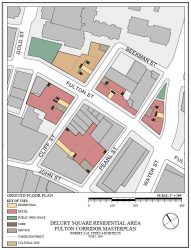LMDC was one of the agencies overseeing the redevelopment of Lower Manhattan in the aftermath of 9-11. Given our previous work for the Port Authority of New York and New Jersey on the World Trade Center site ground lease, RESGroup was selected for a 4-year contract to provide ongoing consulting services to assess the market and financial impacts of major funding proposals for development initiatives in Lower Manhattan. The Fulton Street corridor was a particular area of focus, since part of LMDC’s vision was to make that corridor into one of the main cross-town thoroughfares in lower Manhattan.
RESGroup analyzed long-term historic trends and market conditions in Downtown, Midtown South, and Midtown Manhattan, and projected future potential demand for office, retail, hotel, and residential uses to develop a 20-year strategic vision plan for Lower Manhattan. Financing strategies were also identified to encourage a wide range of potential development in the area.
Prior to 9-11, Lower Manhattan was primarily a commercial location, with office tenants concentrated in the financial and insurance sectors, and few residents. As a result, the neighborhood’s retailers struggled to attract demand outside of business hours, and tourists did not spend more than a few hours in the neighborhood. Since completing our work, Lower Manhattan has become a much more diversified location. A significant increase in residents has helped revitalize the area’s retailers, who are also benefitting from increased hotel development, and a more diversified office sector. Cultural activity has also increased, and development of the Perelman Center at the World Trade Center is imminent.




